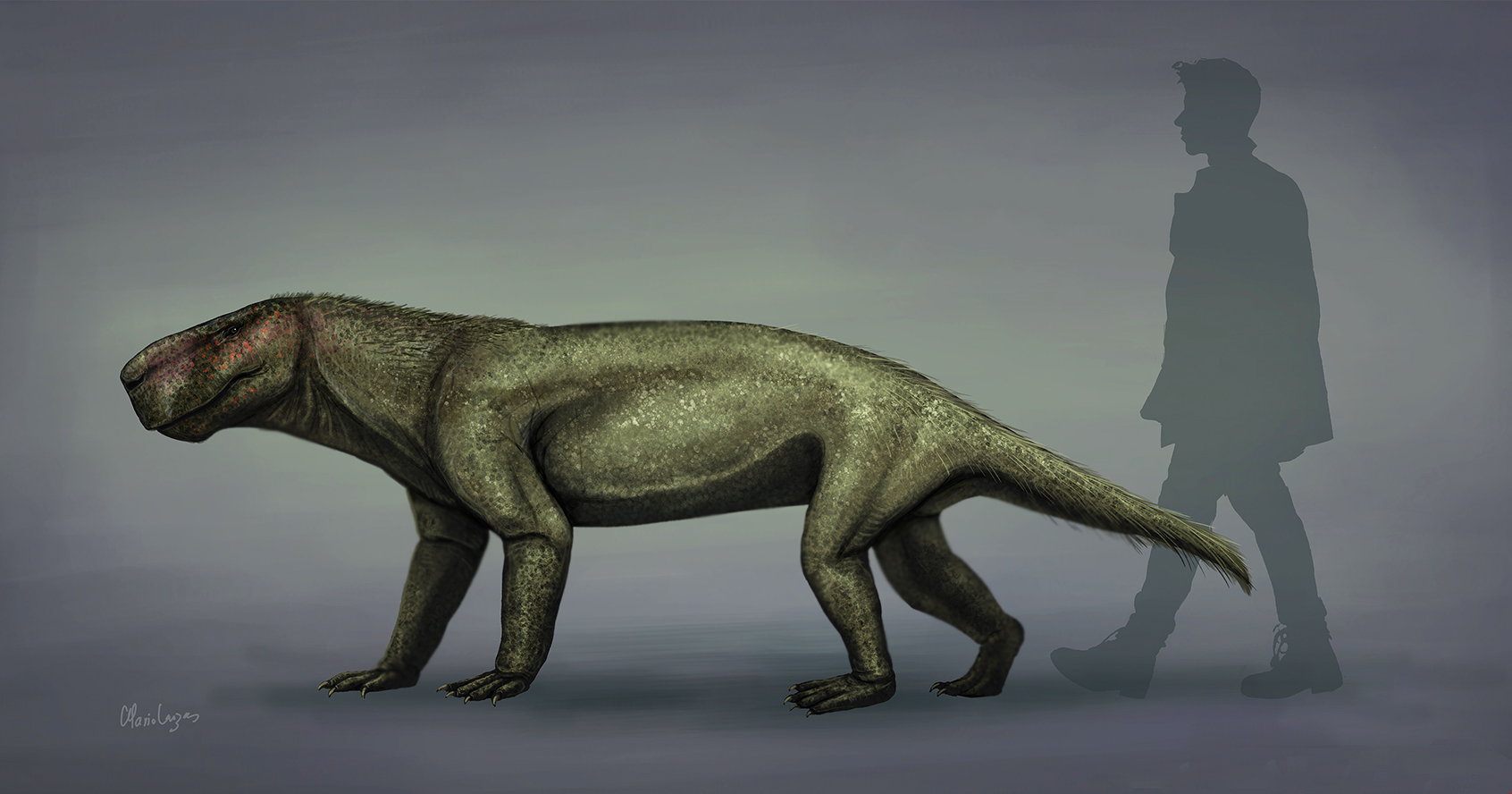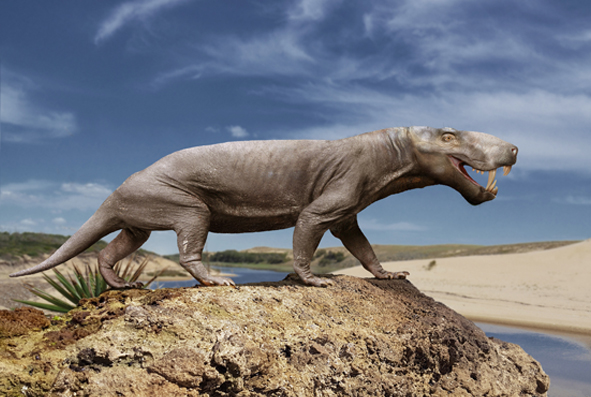|
Eriphostoma
''Eriphostoma'' is an extinct genus of gorgonopsian therapsids known from the Middle Permian (middle Capitanian stage) of ''Tapinocephalus'' Assemblage Zone, South Africa. It has one known species, ''Eriphostoma microdon'', and was first named by Robert Broom in 1911. It is the oldest known gorgonopsian and among the smallest and most basal members of the clade. Description Gorgonopsians were a morphologically conservative group, and like all gorgonopsians, ''Eriphostoma'' would have been a quadrupedal predator. It was among the smaller members of the group, with a skull less than long. It had a relatively short, deep snout and large orbits compared to other gorgonopsians. Like all gorgonopsians, it had five incisors and a canine tooth on each side of the upper jaw, but it had only three small postcanine teeth in its maxilla. The palate of ''Eriphostoma'' has delta-shaped palatine bosses covered in numerous teeth, like '' Gorgonops'' and many basal therapsids, but not more d ... [...More Info...] [...Related Items...] OR: [Wikipedia] [Google] [Baidu] |
Gorgonopsia
Gorgonopsia (from the Greek Gorgon, a mythological beast, and 'aspect') is an extinct clade of sabre-toothed therapsids from the Middle to Upper Permian roughly 265 to 252 million years ago. They are characterised by a long and narrow skull, as well as elongated upper and sometimes lower canine teeth and incisors which were likely used as slashing and stabbing weapons. Postcanine teeth are generally reduced or absent. For hunting large prey, they possibly used a bite-and-retreat tactic, ambushing and taking a debilitating bite out of the target, and following it at a safe distance before its injuries exhausted it, whereupon the gorgonopsian would grapple the animal and deliver a killing bite. They would have had an exorbitant gape, possibly in excess of 90°, without having to unhinge the jaw. They markedly increased in size as time went on, growing from small skull lengths of in the Middle Permian to bear-like proportions of up to in the Upper Permian. The latest gorgonops ... [...More Info...] [...Related Items...] OR: [Wikipedia] [Google] [Baidu] |
Viatkogorgon
''Viatkogorgon'' is a genus of gorgonopsian (a type of therapsid, the group that includes modern mammals) that lived during the Permian period in what is now Russia. The first fossil was found at the Kotelnich locality near the Vyatka River and was made the holotype of the new genus and species ''V. ivachnenkoi'' in 1999. The generic name refers to the river and the related genus '' Gorgonops''—the gorgons of Greek mythology are often referenced in the names of the group. The specific name honors the paleontologist Mikhail F. Ivakhnenko. The holotype skeleton is one of the most complete gorgonopsian specimens known and includes rarely preserved elements such as gastralia (abdominal ribs) and a sclerotic ring (a bony ring inside the eye). A larger, but poorly preserved specimen has also been assigned to the species. The holotype specimen is about long, including the long skull, making ''Viatkogorgon'' a relatively small gorgonopsian. The assigned specimen is larger, with ... [...More Info...] [...Related Items...] OR: [Wikipedia] [Google] [Baidu] |
Abrahamskraal Formation
The Abrahamskraal Formation is a geological formation and is found in numerous localities in the Northern Cape, Western Cape, and the Eastern Cape of South Africa. It is the lowermost formation of the Adelaide Subgroup of the Beaufort Group, a major geological group that forms part of the greater Karoo Supergroup. It represents the first fully terrestrial geological deposits of the Karoo Basin. Outcrops of the Abrahamskraal Formation are found from the small town Middelpos in its westernmost localities, then around Sutherland, the Moordenaarskaroo north of Laingsburg, Williston, Fraserburg, Leeu-Gamka, Loxton, and Victoria West in the Western Cape and Northern Cape. In the Eastern Cape outcrops are known from Rietbron, north of Klipplaat and Grahamstown, and also southwest of East London. Geology The Abrahamskraal Formation comprises the majority of the Middle Permian Beaufort sequence, and are thought to range between 268 - 259 million years in age. The lowermost deposits o ... [...More Info...] [...Related Items...] OR: [Wikipedia] [Google] [Baidu] |
Pristerognathus Assemblage Zone
The ''Pristerognathus'' Assemblage Zone is a tetrapod assemblage zone or biozone which correlates to the upper Abrahamskraal Formation and lowermost Teekloof Formation, Adelaide Subgroup of the Beaufort Group, a fossiliferous and geologically important geological Group of the Karoo Supergroup in South Africa. The thickest outcrops, reaching not more than , occur just east of Sutherland through to Beaufort West in the south and Victoria West in the north. Exposures are also found west of Colesberg and south of Graaff-Reinet. The '' Pristerognathus'' Assemblage Zone is the third biozone of the Beaufort Group. The name of the biozone refers to ''Pristerognathus polyodon'', a medium-sized carnivorous therocephalian therapsid. It is characterized by the presence of this therocephalian species in association with '' Diictodon feliceps'', a small, fossorial dicynodont whose fossils are especially common in this biozone. History The first fossils to be found in the Beaufort Group roc ... [...More Info...] [...Related Items...] OR: [Wikipedia] [Google] [Baidu] |
Pravoslavlevia
''Pravoslavlevia'' is an extinct genus of gorgonopsian therapsids that lived in the late Permian and is part of the Sokolki subcomplex of Russia. It had a skull long. The total length of the animal was about . Only one species (''P. parva'') is known. Classification The following cladogram showing the position of ''Pravoslavlevia'' within Gorgonopsia follows Kammerer and Masyutin, 2018: See also * List of therapsids This list of therapsids is an attempt to create a comprehensive listing of all genera that have ever been included in the Therapsida excluding mammals and purely vernacular terms. The list includes all commonly accepted genera, but also genera tha ... Sources paleodb.org Gorgonopsia Prehistoric therapsid genera Extinct animals of Russia Fossil taxa described in 1953 {{paleo-therapsid-stub ... [...More Info...] [...Related Items...] OR: [Wikipedia] [Google] [Baidu] |
Inostrancevia
''Inostrancevia'' is an extinct genus of carnivorous therapsids, containing the largest members of gorgonopsians, predators characterized by long, saber-tooth-like canines. The various species inhabited European Russia during the Upper Tatarian (Vyatskian), a Russian regional stage equivalent to the Wuchiapingian and Changhsingian stage of the Late Permian period, dating from approximately 259 to 252.3 million years ago. The genus name was described posthumously, after the Bolshevik Revolution, by the Russian paleontologist Vladimir P. Amalitsky in 1922, in honor of geologist Aleksandr Inostrantsev. The first fossils attributed to ''I. alexandri'' are found in Arkhangelsk Oblast, near the Northern Dvina at the end of the 19th century, making it the first gorgonopsian known from Russia, the only place outside Africa where they are officially recognized. Some fossils of the species in question are among the most complete remains of gorgonopsians ever identified to date, t ... [...More Info...] [...Related Items...] OR: [Wikipedia] [Google] [Baidu] |
Smilesaurus
''Smilesaurus'' is an extinct genus of gorgonopsian known from Africa. It lived during the Late Permian. It contains the single species ''S. ferox''. Description ''Smilesaurus'' was a large gorgonopsian, with a skull length of up to 31 centimeters. It is characterized by extremely long canine teeth, and has the proportionally longest canines of any gorgonopsian. Unlike other gorgonopsians, which probably hunted similarly to predatory reptiles, ''Smilesaurus'' probably was a true saber-toothed predator which hunted using similar tactics to saber-toothed cat Machairodontinae is an extinct subfamily of carnivoran mammals of the family Felidae (true cats). They were found in Asia, Africa, North America, South America, and Europe from the Miocene to the Pleistocene, living from about 16 million until ...s. It can be distinguished by other rubidgeines by its lack of cranial pachyostosis and rugosoties, and by its relatively small orbits. Classification The classification of ''S ... [...More Info...] [...Related Items...] OR: [Wikipedia] [Google] [Baidu] |
1911 In Paleontology
Expeditions, field work, and fossil discoveries Institutions and organizations Natural history museums * The Calgary Public Museum opened in Alberta, Canada. Scientific organizations Scientific advances Paleoanthropology Paleobotany Evolutionary biology Exopaleontology Extinction research Micropaleontology Invertebrate paleozoology Trace fossils Vertebrate paleozoology Data courtesy of George Olshevsky's dinosaur genera list. Research techniques Fossil trade Law and politics Regulation of fossil collection, transport, or sale Fossil-related crime Official symbols Protected areas Ethics and practice Hoaxes Scandals Unethical practice People Births Awards and recognition Deaths Historiography and anthropology of paleontology Pseudoscience Popular culture Amusement parks and attractions Art Comics Film Gaming Literature Philately Television See also References {{Reflist, refs= D. H. Tanke. 2010. Lost in plain sight: redis ... [...More Info...] [...Related Items...] OR: [Wikipedia] [Google] [Baidu] |
Tapinocephalus Assemblage Zone
The ''Tapinocephalus'' Assemblage Zone is a tetrapod assemblage zone or biozone which correlates to the middle Abrahamskraal Formation, Adelaide Subgroup of the Beaufort Group, a fossiliferous and geologically important geological Group of the Karoo Supergroup in South Africa. The thickest outcrops, reaching approximately , occur from Merweville and Leeu-Gamka in its southernmost exposures, from Sutherland through to Beaufort West where outcrops start to only be found in the south-east, north of Oudshoorn and Willowmore, reaching up to areas south of Graaff-Reinet. Its northernmost exposures occur around the towns Fraserburg and Victoria West. The ''Tapinocephalus Assemblage Zone'' is the second biozone of the Beaufort Group. The name of the biozone refers to '' Tapinocephalus atherstonei'', a large herbivorous tapinocephalid dinocephalian therapsid. It is characterised by the presence of this dinocephalian species along with the appearance of other advanced tapinocephalid dino ... [...More Info...] [...Related Items...] OR: [Wikipedia] [Google] [Baidu] |
Nochnitsa
''Nochnitsa'' (rus.: ночница, literally – nightling) is a genus of gorgonopsian therapsid from the Kotelnich red beds of Permian Russia. It contains one species, ''Nochnitsa geminidens''. It the most basal known gorgonopsian and among the smallest members of the clade known to date. Discovery and naming ''Nochnitsa'' is known from only one specimen, the holotype KPM 310. It was found in Vanyushonki Member of the Kotelnich red beds, along the Vyatka River in Kirov Oblast, which dates to the latest Guadalupian or early Lopingian epochs. ''Nochnitsa'' is named after the Nocnitsa, a nocturnal hag-like creature from Slavic mythology. Its name was intended as a parallel to the Gorgons, similarly hag-like creatures from Greek mythology, which are the namesake of many genera within Gorgonopsia and the clade as a whole. The name also reflects the nocturnal habits inferred for the genus. The type species name, ''N. geminidens'', means "twin tooth" and refers to one of the autapo ... [...More Info...] [...Related Items...] OR: [Wikipedia] [Google] [Baidu] |







